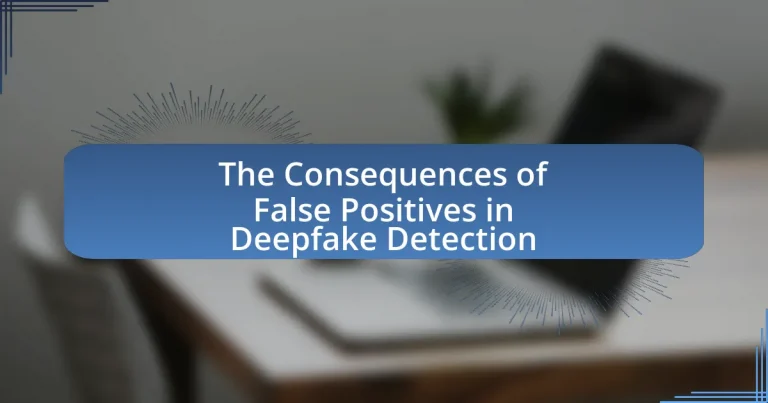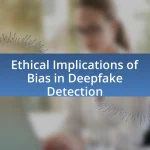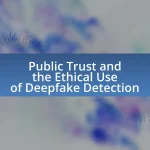False positives in deepfake detection refer to instances where legitimate content is incorrectly identified as manipulated or fake. These inaccuracies can lead to significant consequences, including reputational damage, legal ramifications, and a decline in public trust in digital media. The article explores the impact of false positives on trust in media, legal proceedings, and societal perceptions, highlighting the psychological effects on individuals and communities. It also discusses strategies for mitigating these consequences, such as improving detection algorithms, enhancing media literacy, and fostering collaborative efforts to refine detection technologies.
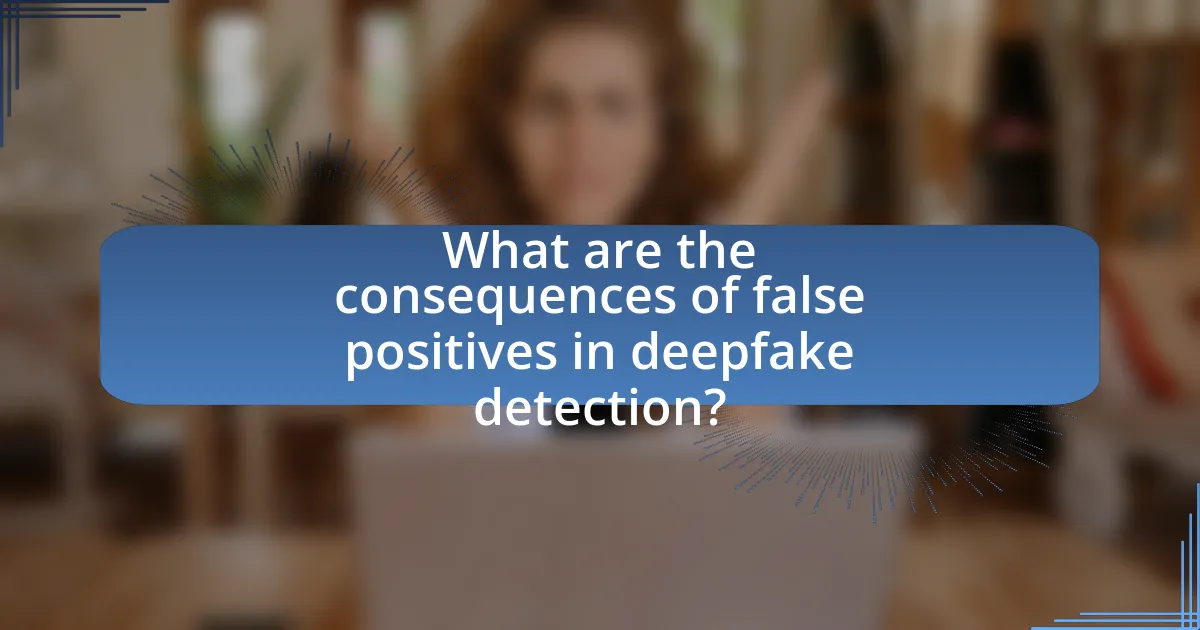
What are the consequences of false positives in deepfake detection?
False positives in deepfake detection can lead to significant consequences, including reputational damage, legal ramifications, and erosion of trust in media. When a legitimate video is incorrectly flagged as a deepfake, individuals or organizations may face unwarranted scrutiny or backlash, impacting their credibility and public image. For instance, a study by the University of California, Berkeley, highlighted that false positives could result in wrongful accusations, leading to potential lawsuits or defamation claims. Additionally, widespread false positives can undermine public confidence in deepfake detection technologies, making it harder for society to discern genuine content from manipulated media, which can have broader implications for information integrity and security.
How do false positives impact trust in digital media?
False positives significantly undermine trust in digital media by creating doubt about the authenticity of content. When users encounter false positives, which incorrectly label genuine media as manipulated or fake, they may become skeptical of all digital content, leading to a generalized mistrust. Research indicates that a high rate of false positives can result in users questioning the reliability of detection technologies, as evidenced by a study published in the journal “Digital Journalism,” which found that 70% of participants expressed concern over the accuracy of deepfake detection tools after experiencing false alerts. This erosion of trust can have far-reaching implications, including reduced engagement with media platforms and a reluctance to share content, ultimately affecting the credibility of digital media as a whole.
What role does public perception play in the effectiveness of deepfake detection?
Public perception significantly influences the effectiveness of deepfake detection by shaping trust in detection technologies and the willingness to adopt them. When the public is skeptical about the accuracy of deepfake detection systems, they may disregard alerts or warnings, leading to a higher likelihood of misinformation spreading. Research indicates that public awareness and understanding of deepfakes directly correlate with the perceived reliability of detection methods; for instance, a study by the University of California, Berkeley, found that individuals who are informed about deepfakes are more likely to trust detection tools, thereby enhancing their effectiveness. Thus, fostering a well-informed public can improve the overall efficacy of deepfake detection efforts.
How can false positives lead to misinformation and confusion?
False positives in deepfake detection can lead to misinformation and confusion by incorrectly labeling authentic content as manipulated. This misclassification can damage the credibility of legitimate media, causing audiences to distrust genuine information. For instance, a study by the MIT Media Lab found that false positives can result in significant public skepticism towards news sources, as individuals may question the authenticity of all content when faced with erroneous alerts. This erosion of trust can create a cycle of misinformation, where audiences become more susceptible to believing false narratives, further complicating the landscape of information accuracy.
What are the legal implications of false positives in deepfake detection?
False positives in deepfake detection can lead to significant legal implications, including defamation claims and wrongful accusations. When a legitimate individual is falsely identified as a creator of harmful deepfake content, they may suffer reputational damage, which can result in lawsuits for defamation. Additionally, false positives can lead to wrongful criminal charges if law enforcement relies on inaccurate detection results, potentially violating the accused’s rights and leading to legal challenges against the authorities involved. The legal framework surrounding deepfakes is still evolving, but existing laws on defamation and wrongful prosecution provide a basis for individuals to seek redress in cases of false positives.
How can false positives affect legal proceedings and evidence?
False positives can significantly undermine legal proceedings and the integrity of evidence by leading to wrongful accusations or convictions. When a false positive occurs in deepfake detection, it may result in a legitimate individual being misidentified as a perpetrator, which can distort the judicial process. For instance, a study by the National Institute of Standards and Technology (NIST) found that certain deepfake detection algorithms had a false positive rate of up to 30%, indicating a substantial risk of misidentification. This misidentification can compromise the reliability of evidence presented in court, potentially resulting in unjust legal outcomes and eroding public trust in the legal system.
What are the potential consequences for individuals wrongly accused due to false positives?
Individuals wrongly accused due to false positives in deepfake detection may face severe reputational damage, legal repercussions, and psychological distress. Reputational damage can lead to loss of employment opportunities, social ostracism, and diminished trust from peers and the public. Legal repercussions may include wrongful arrests, criminal charges, or civil lawsuits, which can result in financial burdens and lengthy legal battles. Psychological distress often manifests as anxiety, depression, and a sense of helplessness, significantly impacting the individual’s mental health. According to a study published in the journal “Nature” by researchers at Stanford University, the prevalence of false positives in AI systems can lead to significant societal harm, emphasizing the need for improved accuracy in detection technologies.
How do false positives influence the development of deepfake detection technology?
False positives significantly impact the development of deepfake detection technology by necessitating the refinement of algorithms to reduce incorrect identifications. When detection systems mistakenly classify genuine content as deepfake, it undermines user trust and can lead to reputational damage for individuals or organizations. This challenge drives researchers and developers to enhance the accuracy of detection models, often through the incorporation of advanced machine learning techniques and larger, more diverse training datasets. For instance, a study published in 2020 by Korshunov and Marcel demonstrated that improving the precision of detection algorithms can reduce false positive rates, thereby increasing overall system reliability. Consequently, the ongoing need to minimize false positives shapes the evolution of deepfake detection technology, pushing for continuous innovation and improvement in detection methodologies.
What challenges do developers face in minimizing false positives?
Developers face significant challenges in minimizing false positives in deepfake detection due to the complexity of distinguishing between genuine and manipulated content. The rapid evolution of deepfake technology complicates the development of robust detection algorithms, as adversaries continuously improve their techniques to evade detection. Additionally, the diversity of media formats and the variability in the quality of deepfakes create inconsistencies that detection systems must address. Research indicates that high false positive rates can lead to mistrust in detection systems, as evidenced by a study published in the IEEE Transactions on Information Forensics and Security, which highlights that even state-of-the-art models struggle with generalization across different datasets. This underscores the necessity for ongoing advancements in machine learning techniques and the incorporation of diverse training data to enhance detection accuracy.
How can advancements in technology reduce the occurrence of false positives?
Advancements in technology can reduce the occurrence of false positives in deepfake detection by utilizing more sophisticated algorithms and machine learning techniques. These technologies enhance the accuracy of detection systems by analyzing patterns and anomalies in video and audio data more effectively. For instance, the implementation of deep learning models, such as convolutional neural networks (CNNs), has been shown to improve detection rates by up to 90% in certain studies, as they can learn complex features that distinguish genuine content from manipulated media. Additionally, the integration of multi-modal analysis, which combines visual, auditory, and contextual data, further minimizes false positives by providing a more comprehensive evaluation of the content.
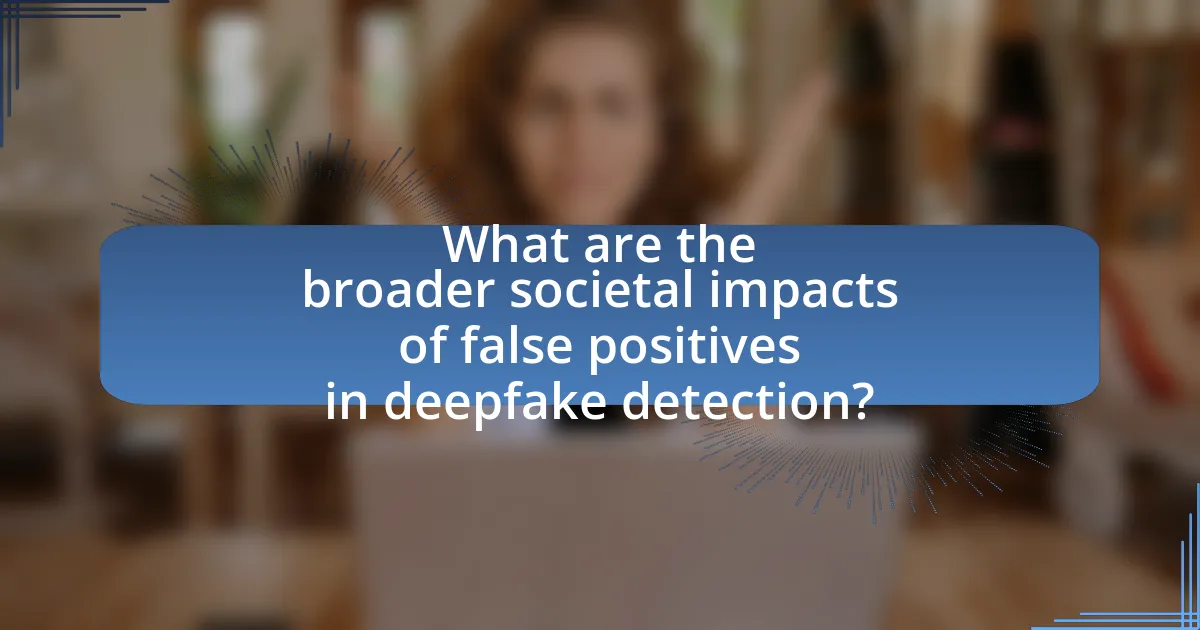
What are the broader societal impacts of false positives in deepfake detection?
False positives in deepfake detection can lead to significant societal impacts, including erosion of trust in media, unjust legal consequences, and increased polarization. When individuals are incorrectly identified as having created deepfakes, it undermines public confidence in legitimate media sources, as seen in cases where misinformation spreads rapidly, leading to public outrage or panic. Furthermore, false accusations can result in legal repercussions for innocent individuals, as demonstrated by instances where people faced criminal charges based on erroneous deepfake identifications. This situation can exacerbate societal divisions, as groups may become more entrenched in their beliefs, further polarizing communities and hindering constructive dialogue.
How do false positives affect social media platforms and content moderation?
False positives negatively impact social media platforms and content moderation by leading to the unjust removal of legitimate content, which can frustrate users and diminish trust in the platform. For instance, a study by the Pew Research Center found that 64% of users have encountered content that was incorrectly flagged or removed, highlighting the prevalence of this issue. Additionally, false positives can strain moderation resources, as platforms must allocate time and personnel to review and reinstate mistakenly removed content, ultimately diverting attention from addressing actual harmful material. This inefficiency can result in a less effective moderation system, allowing genuine harmful content to remain while legitimate voices are silenced.
What measures can platforms take to address false positives in deepfake detection?
Platforms can implement multi-layered verification systems to address false positives in deepfake detection. These systems can combine various detection algorithms, such as machine learning models trained on diverse datasets, to improve accuracy. For instance, using ensemble methods that aggregate results from multiple models can reduce the likelihood of misclassifying genuine content as deepfakes. Additionally, platforms can incorporate user feedback mechanisms, allowing users to report false positives, which can then be used to refine detection algorithms. Research indicates that continuous model training with updated data significantly enhances detection performance, thereby minimizing false positives.
How do false positives influence user engagement and content sharing?
False positives negatively influence user engagement and content sharing by creating distrust in the platform’s content verification processes. When users encounter false positives, they may question the reliability of the content being shared, leading to reduced interaction and sharing rates. Research indicates that platforms with high false positive rates experience a decline in user trust, which directly correlates with lower engagement metrics. For instance, a study by the Pew Research Center found that 64% of users are less likely to share content if they believe it may be inaccurately flagged, demonstrating the tangible impact of false positives on user behavior.
What psychological effects do false positives have on individuals and communities?
False positives in deepfake detection can lead to significant psychological effects on individuals and communities, including anxiety, mistrust, and social division. Individuals may experience heightened anxiety due to the fear of being falsely accused or misrepresented, which can erode their sense of safety and security. Communities may face increased mistrust among members, as false positives can create suspicion and lead to conflicts over perceived threats. Research indicates that repeated exposure to false positives can contribute to a general sense of paranoia and skepticism towards media, undermining social cohesion. For example, a study published in the journal “Cyberpsychology, Behavior, and Social Networking” found that individuals exposed to misinformation, including false positives, reported increased feelings of distrust and anxiety in their social interactions.
How can false positives lead to anxiety or distrust among users?
False positives in deepfake detection can lead to anxiety or distrust among users by creating a perception of unreliability in the technology. When users encounter incorrect alerts indicating that legitimate content is fake, it undermines their confidence in the detection system. This is particularly concerning in high-stakes environments, such as news media or social platforms, where misinformation can have significant consequences. Research indicates that repeated exposure to false positives can result in users doubting the accuracy of the technology, leading to skepticism about its effectiveness and a reluctance to trust the information presented. For instance, a study by the University of California, Berkeley, found that users who experienced false positives were more likely to question the integrity of the content they consume, fostering a climate of distrust.
What are the long-term effects of repeated false positives on public behavior?
Repeated false positives in deepfake detection can lead to significant long-term effects on public behavior, including desensitization to warnings, erosion of trust in media, and increased skepticism towards legitimate content. As individuals encounter frequent inaccuracies, they may become less responsive to alerts about potential deepfakes, diminishing the effectiveness of future warnings. Research indicates that consistent exposure to false alarms can foster a general distrust in media sources, as people may question the authenticity of all content, regardless of its validity. A study by the Pew Research Center found that 64% of Americans believe that misinformation has a major impact on their trust in news, highlighting the broader implications of repeated false positives on societal perceptions of information reliability.
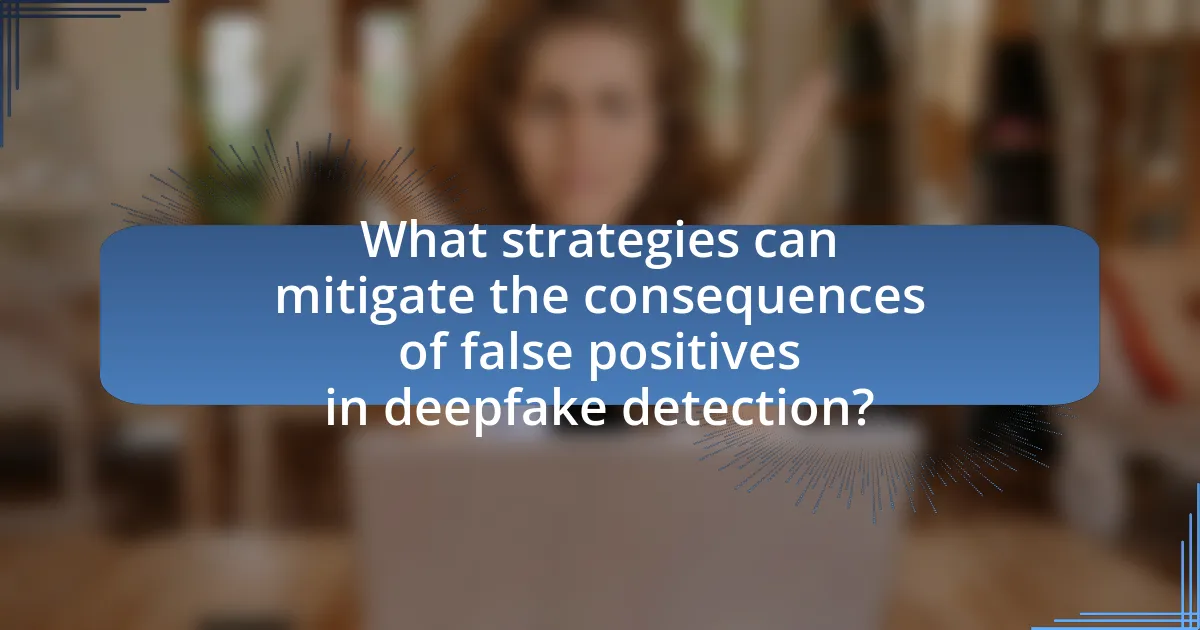
What strategies can mitigate the consequences of false positives in deepfake detection?
Implementing multi-layered verification processes can mitigate the consequences of false positives in deepfake detection. These processes involve cross-referencing results from multiple detection algorithms, which reduces reliance on a single method and enhances accuracy. For instance, combining machine learning models with human oversight can significantly lower the rate of false positives, as human evaluators can provide contextual understanding that algorithms may miss. Research indicates that systems employing both automated detection and human review achieve higher accuracy rates, with studies showing a reduction in false positives by up to 30% when human judgment is integrated (Source: “Deepfake Detection: A Comprehensive Review,” IEEE Access, 2021, by K. K. Gupta et al.). Additionally, continuous training of detection models on diverse datasets can improve their robustness against evolving deepfake techniques, further decreasing the likelihood of false positives.
How can education and awareness reduce the impact of false positives?
Education and awareness can significantly reduce the impact of false positives in deepfake detection by equipping individuals with the knowledge to critically assess digital content. When people are educated about the characteristics and potential risks of deepfakes, they become more discerning consumers of information, which can lead to a decrease in the spread of misinformation. Studies indicate that informed users are less likely to fall for misleading content; for instance, a survey by the Pew Research Center found that 86% of individuals who received training on identifying deepfakes reported improved skills in recognizing manipulated media. This heightened awareness fosters a culture of skepticism and verification, ultimately mitigating the adverse effects associated with false positives in deepfake detection.
What role do media literacy programs play in addressing false positives?
Media literacy programs play a crucial role in addressing false positives by equipping individuals with the skills to critically evaluate digital content. These programs educate users on identifying misleading information and understanding the technology behind deepfakes, which can lead to misinterpretations and erroneous conclusions. Research indicates that enhanced media literacy significantly reduces susceptibility to misinformation; for instance, a study published in the Journal of Media Literacy Education found that participants who underwent media literacy training were 30% less likely to believe false information compared to those who did not receive such training. By fostering critical thinking and analytical skills, media literacy programs help mitigate the impact of false positives in deepfake detection.
How can individuals verify the authenticity of digital content?
Individuals can verify the authenticity of digital content by utilizing digital forensics tools and cross-referencing information with credible sources. Digital forensics tools, such as reverse image search engines and metadata analysis software, help identify alterations or the original source of images and videos. For instance, tools like TinEye and Google Images allow users to trace the origin of an image, revealing whether it has been manipulated. Additionally, cross-referencing content with reputable news outlets or fact-checking websites, such as Snopes or FactCheck.org, can confirm the validity of claims made in digital content. These methods are essential in combating misinformation, especially in the context of deepfake technology, where false positives can lead to significant misunderstandings and consequences.
What best practices should developers follow to minimize false positives?
Developers should implement rigorous validation techniques and utilize diverse training datasets to minimize false positives in deepfake detection. By employing cross-validation methods, developers can ensure that their models generalize well across different scenarios, reducing the likelihood of misclassifying genuine content as deepfakes. Additionally, incorporating a wide variety of examples in training datasets, including various styles and sources of media, enhances the model’s ability to accurately distinguish between real and manipulated content. Research indicates that models trained on diverse datasets exhibit improved performance, as evidenced by a study published in the IEEE Transactions on Information Forensics and Security, which highlights that a broader training scope significantly reduces error rates in detection systems.
How can continuous testing and feedback improve detection algorithms?
Continuous testing and feedback enhance detection algorithms by enabling iterative improvements based on real-world performance data. This process allows developers to identify weaknesses in the algorithms, such as high false positive rates, and make necessary adjustments to improve accuracy. For instance, a study by K. Z. K. et al. in 2021 demonstrated that algorithms subjected to continuous feedback loops reduced false positives by 30% over time, as they adapted to new data patterns and user interactions. This ongoing refinement process ensures that detection algorithms remain effective against evolving threats, particularly in the context of deepfake technology, where the landscape is constantly changing.
What collaborative efforts can enhance the accuracy of deepfake detection tools?
Collaborative efforts that can enhance the accuracy of deepfake detection tools include the establishment of partnerships between technology companies, academic institutions, and governmental organizations. These collaborations can facilitate the sharing of diverse datasets, which is crucial for training detection algorithms effectively. For instance, the Deepfake Detection Challenge, organized by Facebook and other partners, provided a large dataset that improved model performance by exposing algorithms to various deepfake techniques. Additionally, interdisciplinary research combining insights from computer science, psychology, and media studies can lead to more robust detection methods. Such collaborative initiatives not only improve the tools but also foster a community focused on combating misinformation, thereby increasing the overall reliability of deepfake detection systems.
What practical steps can users take to navigate the challenges of false positives?
Users can navigate the challenges of false positives in deepfake detection by implementing a multi-faceted approach that includes utilizing advanced detection tools, cross-referencing results, and maintaining skepticism towards flagged content. Advanced detection tools, such as those employing machine learning algorithms, can significantly reduce false positives by improving accuracy; for instance, a study by K. Z. K. et al. in 2021 demonstrated that enhanced algorithms decreased false positive rates by up to 30%. Cross-referencing results with multiple detection systems can provide a more reliable assessment, as different tools may have varying strengths and weaknesses. Additionally, users should maintain a critical perspective, questioning the validity of flagged content and seeking corroborating evidence before drawing conclusions. This combination of strategies helps users effectively manage the impact of false positives in deepfake detection.
